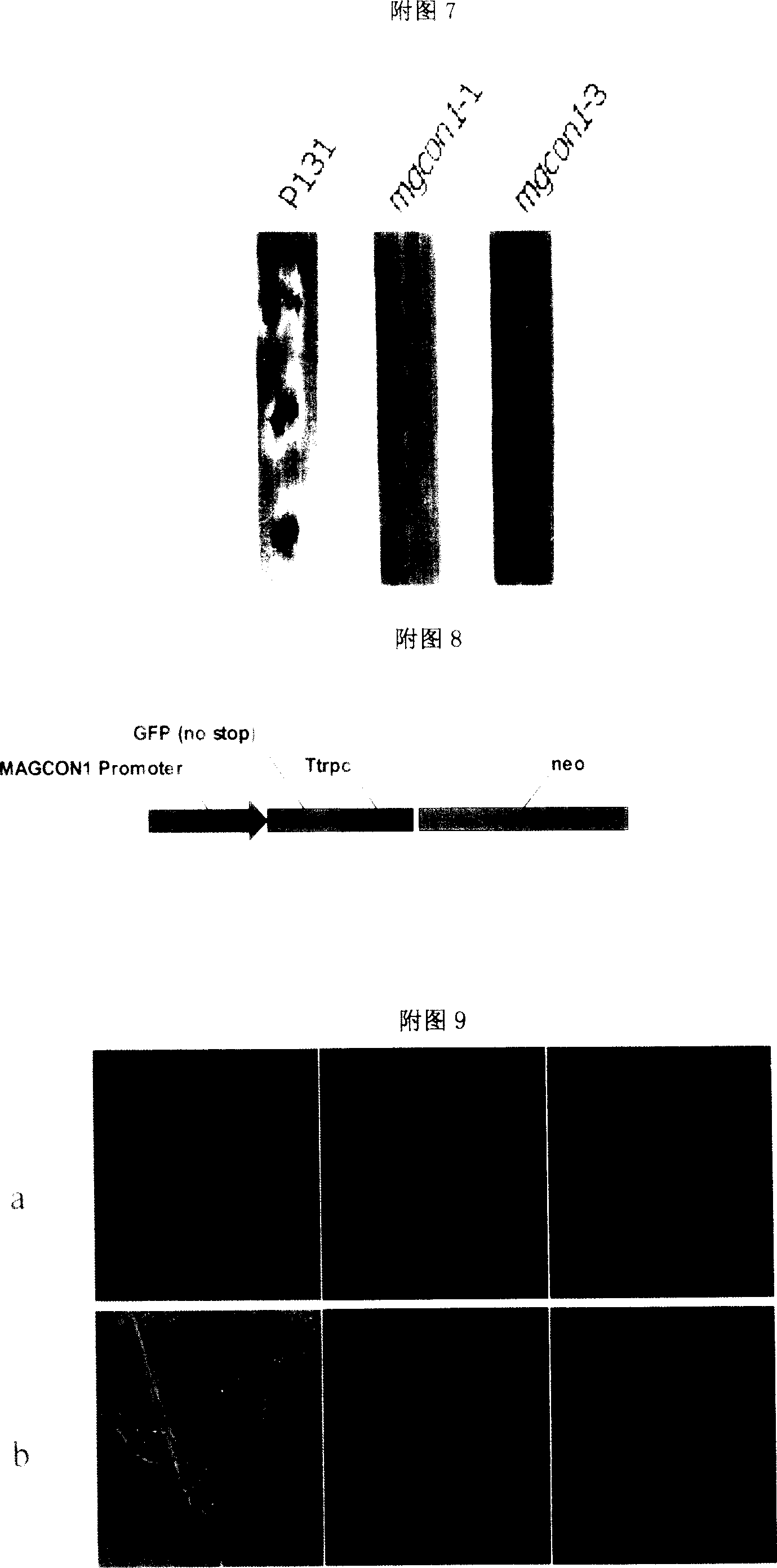Novel gene necessary for production of conidium from Magnaporthe grisea and its uses
A technology of conidia and pyrosporium, applied in the direction of genetic engineering, plant genetic improvement, application, etc.
- Summary
- Abstract
- Description
- Claims
- Application Information
AI Technical Summary
Problems solved by technology
Method used
Image
Examples
Embodiment 1
[0039] Embodiment 1, pyrosporium conidia produce the isolation of essential gene MgCON1
[0040] 1. Screening and identification of mutants
[0041] a, the construction of the REMI transformant library of pyrosporium strain P131
[0042] A large amount of pUCATPH was extracted by alkaline lysis (Lu, S., Lyngholm, L., Yang, G., Bronson, C., Yoder, O.C. 1994. Tagged mutants at the Toxl locus of Cochliobolusheterostrophus by restriction enzyme-mediated integration. Proc. Natl.Acad.Sci.USA 91:1264-12653) of the plasmid DNA, respectively with restriction endonuclease HindIII, KpnI, SacI and SmaI digestion with its linearization, according to the method of REMI transformation (Shi Z., Christian D ., & Leung H., Enhanced transformation in Magnaporthe grisea by restriction enzyme mediated integration of plasmad DNA. Phytopathology, 1995, 85: 329-333.) Transform wild-type pyrosporium strain P131. Add 2 micrograms of linearized plasmid and corresponding restriction endonucleases to ea...
Embodiment 2
[0061] Demonstration of the role in the production of embodiment 2, MgCON1 pyrosporium conidia
[0062] Including complementation experiments and gene replacement experiments. This part includes the construction of complementary vectors and gene replacement vectors and the introduction of the above two types of vectors into Pyrosporium to obtain corresponding transformants. The construction of the complementary vector refers to the DNA fragment comprising the full-length functional sequence of MgCON1 (the 2253rd nucleotide to the 4019th nucleotide of contig2.767 in the Pyrosporium genome database) and a DNA fragment with a new The carrier of the mycin resistance gene was linked. The recipient strain of Pyricularia sp. introduced by the complementary vector is a mutant strain. Here, the neomycin resistance gene is not a limitation of the present invention, and other genes that can cause antibiotic resistance, that is, genes that cause fungal resistance other than the neomycin...
Embodiment 3
[0082] Example 3, comparison of the infection ability of wild-type bacteria P131 and MgCON1 deletion mutants
[0083] Inoculate the wild-type bacteria P131, the MgCON1 deletion mutants mgcon1-1 and mgcon1-3 on the tomato juice oatmeal medium plate, and after culturing for 5 days at 26°C-28°C, cut fresh mycelium pieces of 3mm×3mm with a scalpel As the inoculum adhered to the leaves of Lijiang Xintuan Heigu, the inoculated rice leaves were placed at 26°C in the dark for 24 hours, and then transferred to 26°C under light for 72 hours before taking pictures. From the results in Figure 7, it can be seen that the wild-type strain P131 formed typical susceptible lesions on rice leaves, while the MgCON1 deletion mutants mgcon1-1 and mgcon1-3 did not form susceptible lesions, indicating that it completely lost the ability to invade. The ability to dye rice (the results are shown in Figure 7).
PUM
| Property | Measurement | Unit |
|---|---|---|
| diameter | aaaaa | aaaaa |
Abstract
Description
Claims
Application Information
 Login to View More
Login to View More - R&D
- Intellectual Property
- Life Sciences
- Materials
- Tech Scout
- Unparalleled Data Quality
- Higher Quality Content
- 60% Fewer Hallucinations
Browse by: Latest US Patents, China's latest patents, Technical Efficacy Thesaurus, Application Domain, Technology Topic, Popular Technical Reports.
© 2025 PatSnap. All rights reserved.Legal|Privacy policy|Modern Slavery Act Transparency Statement|Sitemap|About US| Contact US: help@patsnap.com



